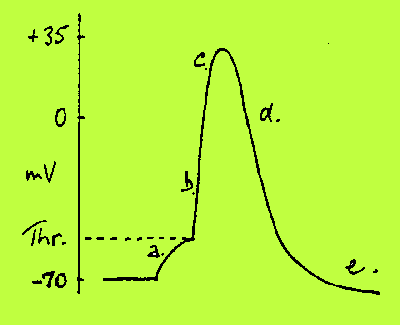Neurobiology (Book 2) - Ions & Potentials (Ch. 3)
Back to neuro-revision list or Tutorial
7 notes or BBB Home Page
Ions (§3.2):
cations (positively charged), e.g. Na+, K+, Ca++
anions (negatively charged), e.g. Cl-
Extracellular fluid
Intracellular fluid
Diffusion (§3.2):
Concentration gradients: movement from high conc. to low conc.
Potential gradients: like (same) charges repel; unlike (different)
charges attract
Equilibrium: no net movement (flux); equal movements in each
direction (dynamic equilibrium).
Membranes:
Structure: double layer of lipid molecules (fats)
Proteins: form channels in membrane for ions to pass though receptors
for hormones, neurotransmitters
Channels in membrane are selectively permeable: membrane is semi-permeable
Resting membrane potential (3.3)
Due mainly to potassium [K+] gradient across membrane
Role of Na+ / K+ pump (active transport) - maintenance
of gradients
Action potentials (3.6):
Voltage gated channels: influence of membrane potential

Stages in the action potential:
a. Depolarisation to Threshold : Na+ channels opened
b. Na+ influx - further depolarisation
c. Closure of Na+ channels; K+ channels open
d. K+ efflux - repolarisation
e. Restoration of resting membrane potential
N.B. Very few ions cross the membrane during an AP
Refractory period - due to inactivation of Na+ channels
Speed of propagation of APs (3.8)
axon diameter: conduction velocity increased with increasing diameter
myelination increases conduction velocity for given axon diameter
(But why do mammals still have lots of unmyelinated axons?)
Back to neuro-revision list or Tutorial
7 notes or BBB Home Page

